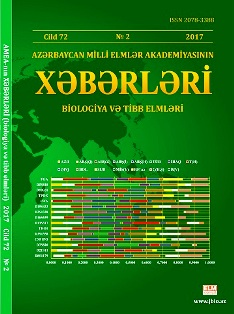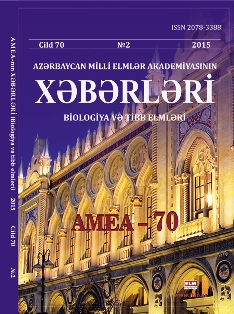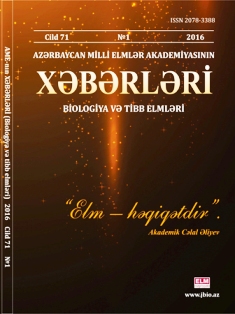
Stability, plasticity, and adaptability of winter bread wheat under rainfed conditions with unstable moisture supply
Research article: Stability, plasticity, and adaptability of winter bread wheat under rainfed conditions with unstable moisture supply
Author: Jahangirov Atabay Agasoltan
Gobustan Regional Experimental Station, Research Institute of Crop Husbandry, Ministry of Agriculture of the Republic of Azerbaijan, Gobustan AZ 3700, Azerbaijan
For correspondence: a.cahangir@hotmail.com
Received: January 17, 2022; Received in revised form: March 10, 2022; Accepted: March 16, 2022
Abstract: Productivity, stability, plasticity, and adaptability of 14 varieties and 1 line of winter bread wheat were studied in Mountenous Shirvan, under rainfed conditions with no stable humidıty, in 2010/2011-2017/2018 vegetation years. Based on hydrometeorological indicators, the climatic conditions of 2010-2011, 2012-2013, 2016-2017, and 2017-2018 vegetation years were considered favorable for the development of winter wheat, and the climatic conditions of 2014-2015 and 2015-2016 were moderate and the climatic conditions of 2011-2012 and 2013- 2014 were found to be unfavorable. In 2011, 2013, 2017, and 2018, the average productivity for all genotypes was the highest and amounted to 61.3, 69.8, 66.9, and 66.6 cwt/ha, respectively. In 2015 and 2016, productivity was moderate, while in 2012 and 2014, it was at a low level. The average productivity over the years was in line with the climatic conditions during the vegetation year. According to the average of 8 years, Gobustan, 7th WON-SA №465, and Gyrmyzy gul 1 genotypes had the highest productivity - 66.4, 63.4, and 60.4 cwt/ha, respectively. Azeri, Bezostaya 1, Murov 2, Ruzi 84, and Sheki 1 varieties showed the lowest results. Taking into account the stability and plasticity of the studied varieties, it was concluded that Bezostaya 1, Ruzi 84, and Sonmez 01 varieties belong to the neutral type with the least plasticity (i.e. the type with wide adaptability). The varieties 7 thWON-SA №465 and Gobustan manifested a specific adaptation with high plasticity, increased productivity in response to high agrophone and favorable climatic conditions, as well as adaptability to adverse conditions. Therefore, the cultivation of these varieties in areas with unstable moisture supply, such as Mountainous Shirvan, and in a high agrophone, creates conditions for obtaining good results. In addition to not being adapted to unfavorable conditions, Tale 38 and Azamatli 95 varieties were found to have narrow adaptability and high plasticity in response to improved conditions.
Keywords: Winter bread wheat, rainfed conditions, productivity, stability, plasticity, adaptability
References
Aliev J.A. (2000) Physiological bases of wheat breeding tolerant to water stress. Proceedings of the 6th International Wheat Conference: Wheat in a global environment. Hungary: Budapest, 9: 693-698.
Aliev J.A. (2001) Diversity of photosynthetic activity of organs of wheat genotypes and breeding of high-yielding varieties tolerant to water stress. Proceedings of the 12th International Congress on Photosynthesis. Australia: Brisbane, p. 28-006.
Aliyev J. (2012) Photosynthesis, photorespiration and productivity of wheat and soybean genotypes. Physiologia Plantarum, 145: 369-383.
Aliyev J.A., Huseynova I.M. (2014) Genotypic Variation for drought tolerance in wheat plants. P. Ahmad et al. (eds.). Improvement of Crops in the Era of Climatic Changes, Springer Science+Business Media, New York, 2: 151-169; doi: 10.1007/978-1-4614-8824-8-6.
Eberhart S.A., Russell W.A (1966) Stability parameters for comparing varieties. Crop Sci., 6: 36-40.
Finlay K.W., Wilkonson G. N. (1963) The analysis of adaptation in a plant breeding programme. J. Agric. Res., 14: 742-754
Mameev V.V., Nikiforov V.M. (2015) Evaluation of yield, adaptability, ecological stability and plasticity of winter wheat varieties in the Bryansk region conditions. Bulletin of the Kursk State Agricultural Academy, No 7: 125-129. (in Russ.). https://www.elibrary.ru/item.asp?id=28899333
Petrov L.K., Selekhov V.V. (2016) Results of the study of winter wheat varieties in the Nijegorod region conditions. Agrarian Science of the Euro-North-East, 2 (51): 24-28. (in Russ.)
Samofalova N.E., Dubinina O.A., Samofalov A.P., Ilichkina N.P. (2019) The role of meteorological factors in formation of the productivity of winter durum wheat. Grain Economy of Russia, 5(65): 18-23; https://doi.org/10.31367/2079-8725-2019-65-5-18-23) (in Russ.)
Sharma R.C., Morgounov A.I., Braun H.J., Akin B., Keser M., Kaya Y., Khalikulov Z., Ginkel M., Yahyaoui A., Rajaram S. (2012) Yield stability analysis winter wheat genotypes targeted to semi-arid environments in the International Winter Wheat Improvement Program. International Journal of Plant Breeding © Global Science Books, p. 7-13.
Sharma R.C., Rajaram S., Khalikulov S., Ziyaev Z., Hazratkulova S., Khodarahami M., Nazeri S.M., Belen S., Khalikulov Z., Mosaad M., Kaya Y., Keser M., Eshonova Z., Kokhmetova A., Ahmedov M.G., Jalal Kamali M.R., Morgounov A.I. (2013) Improved winter wheat phenotypes for Central and West Asia. Euphytica, 190: 19-31; doi: 10.1007/s10681-012-0732-y . p.19-31.
Zhuchenko A.A. (2001) Adaptive system of plant breeding (ecological bases): monograph [in 2 volumes]. - M.: Publishing house Rudn., 1: 780 p. (in Russ.).























